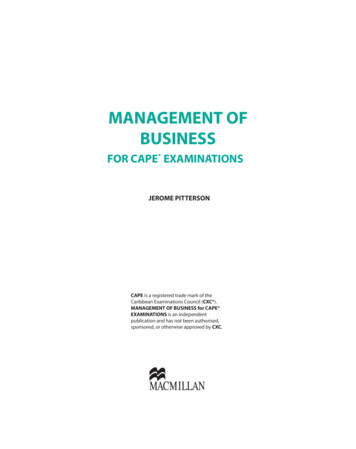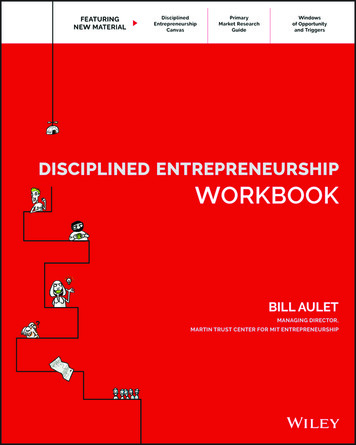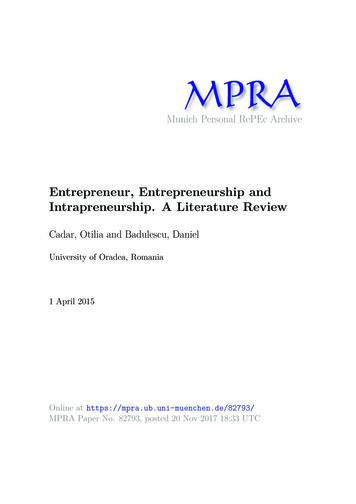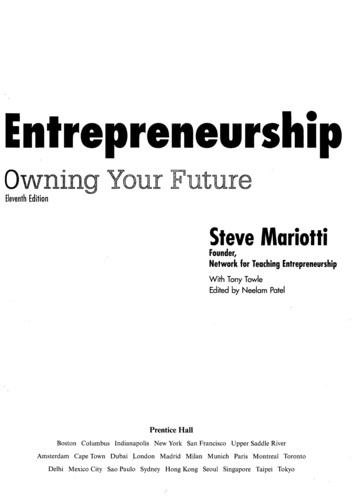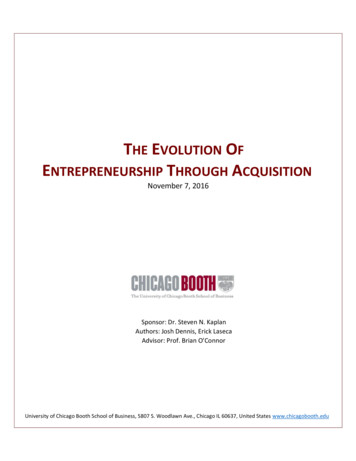
Transcription
THE EVOLUTION OFENTREPRENEURSHIP THROUGH ACQUISITIONNovember 7, 2016Sponsor: Dr. Steven N. KaplanAuthors: Josh Dennis, Erick LasecaAdvisor: Prof. Brian O’ConnorUniversity of Chicago Booth School of Business, 5807 S. Woodlawn Ave., Chicago IL 60637, United States www.chicagobooth.edu
The Evolution of Entrepreneurship Through AcquisitionTable of ContentsI. Introduction. 1II. Entrepreneurship through Acquisition Overview . 2Origin and History . 2The Traditional Search Fund Model . 3Historical Success Rates and Returns . 7Alternative Forms of ETA . 7III. Conversations with Investors . 11Overview of Investors Interviewed . 11The Three Pillars. 12Size and Dynamics of the Market . 13Growth as Driver of Emerging ETA Models . 13Investors are Busier Than Ever Before . 15The Profile of the Typical Entrepreneur is Changing. 15Industries and Target Companies . 16Investors and the Future of ETA . 16IV. The Evolution and Growth of ETA . 171983–1999: Proof of Concept . 172000–2012: Growth and Maturation . 182013–Present: Institutionalization and Differentiation . 20V. Parting Thoughts . 21
The Evolution of Entrepreneurship Through AcquisitionI. IntroductionAs 2016 draws to a close, the Entrepreneurship Through Acquisition (ETA) community is in a uniquesituation. ”Search funds”, the predominant model historically and the focus of this report, has had anamazing run under a mostly consistent model, through a relatively finite set of investors and drawing froma handful of elite business school programs. Now, new models and investors are funding moreentrepreneurs than ever, and this trend is gaining momentum. The space has grown from a cottageindustry in 1983 into what investors describe as a period of “explosion”, “take-off” and “proliferation”referring to the search fund space in 2016.In order to better understand these trends, we conducted a study of the asset class by analyzing theavailable data and through conversations with a broad cross-section of investors. The data show a healthysector with a robust pool of available companies, a plentiful source of capital, a growing pool of talentedsearch fund entrepreneurs and a more experienced group of search fund investors. The conversationswith these investors support much of the performance data and add color to recent trends that have notyet had an impact on performance.The goal of this paper is to explore how growth and change will affect ETA going forward. We begin byreviewing the origins of the traditional model and the variations that have begun to emerge more recently.We then summarize our interviews with investors, where we outline the common themes that support,or in some cases add, to existing data. Later, we analyze the growth of ETA through different time periods,focusing on the primary drivers of success and incentives for different parties. We conclude by sharing theperspective we gained after analyzing all of this information.CONTRIBUTORSThis report was made possible by the generous contribution of insights from the individuals listed below,as well as others who chose to remain anonymous:Coley AndrewsRich AugustynTomas BergstrandTim BovardMatt BurrTim CassultPaul (Lew) Davies IIIDavid DodsonLarry DunnJim EdmundsBill EganMatt EstepPaul FurlowAaron GabbartIrv GrousbeckRob JohnsonW. Shannon JonesChris KillackeyDave LazierTom MalloyMichael MilesSandro MinaAaron MobarakM-K O’ConnellBob OsterJim PerryJürgen RillingGerald RiskAndrew SaltounDustin Sellers1Mike SmerkloJim SouthernMartin SteberJose StellaJeff StevensWill ThorndikeDoug TudorJamie TurnerA.J. WassersteinSimon Webster
The Evolution of Entrepreneurship Through AcquisitionII. Entrepreneurship Through Acquisition OverviewOrigin and HistoryThe search fund model was developed in 1983, when Irving Grousbeck, then a professor at HarvardBusiness School (“HBS”) and now the Director of the Center of Entrepreneurial Studies at Stanford GSB,assisted young entrepreneurs to acquire and operate small businesses. One of the first recognizedexamples is Nova Capital, founded by Jim Southern in 1984. After forming Nova with investments fromformer business associates and professors, Southern began to reach out to business owners looking tosell. He eventually came across Uniform Printing, the business forms division of a publicly traded printingcompany. At 40 million in revenue with over 750 employees, it was a sizeable business for a first-timeCEO. However, with mentorship and guidance from his investors, Southern was able to grow UniformPrinting substantially over the next 10 years. In 1994, Southern and his investors sold the business,generating an ROI of over 24x.While Nova Capital was one of the better performers, it was not the only search fund to produceoutstanding returns. The model was risky, but relatively straightforward and replicable. As Mr. Grousbeckhad predicted, many owners of fundamentally sound businesses were approaching retirement age andseeking liquidity, but had not put a succession plan in place. The search fund concept offered a solutionfor each of these issues. Further, a large percentage of the owners had been content with the business forseveral years and had neither the desire nor the risk tolerance to invest in aggressive growth. Young,capable entrepreneurs with the right advisors had the potential to find, acquire and grow thesebusinesses; thus, the search fund model was born.Over 30 search funds were raised between 1984–1999. During that time, a small community of 15–20individuals accounted for the majority of capital invested in search funds. To entrepreneurs, this grouprepresented the ideal investor base for several reasons. First, they had access to capital and deep networksto assist in sourcing, advising and funding opportunities. Also, they understood the nuances of the modelas their experiences investing in and operating businesses via the search fund model gave them anunderstanding of the types of businesses to look for and the operational levers to pull to create value.Finally, the group had a passion for mentoring young, talented entrepreneurs as they led companies intothe next phases of growth. As nearly every searcher will attest, guidance and coaching are critical tosuccess in ETA, and this group was qualified and willing to offer both.As successful outcomes continued to occur, the model gained momentum and experienced exponentialgrowth. Between 2000–2005, the number of search funds doubled the combined total of the previous 15years. From 2005–2013, over 100 more search funds were raised. The number continues to grow: near200 total search funds have been raised to date, of which 75% successfully acquired a company. As of2013, search funds have produced a cumulative IRR of 34.9% and ROI of 10.0x.There have been several consequences to the recent influx of people and capital into the asset class. First,the traditional search fund model, still the most common form of ETA, has become standardized―termsand structure are effectively the same for every entrepreneur. Furthermore, new and innovative strategiesfor pursuing ETA are being developed. From funds of funds and search fund accelerators to self-funded oreven crowdfunded searches, there now exists an array of alternatives for entrepreneurs to consider2
The Evolution of Entrepreneurship Through AcquisitionThe Traditional Search Fund ModelThe traditional search fund model is still nearly identical to the method Jim Southern utilized in 1983.Today, however, the process of raising a search fund is more standardized and typically entails four stages.Stage 1: Raising and Structuring Search CapitalSearch capital overview: The first major step is raising a pool of capital intended to fund expensesassociated with searching for a business―the “search phase”. Capital raised for the search phase is usedto pay the searcher a salary and cover expenses such as office space, travel, diligence costs, etc. for aperiod that usually lasts up to two years. The amount typically varies between 300K– 400K for a solosearch and 600K– 700K for a partnership (as detailed in Exhibit A below).Exhibit A: Representative Search Fund BudgetsFundraising: For the majority of searchers, the fundraising process begins long before they formally raiseany capital. Raising a search fund is a major decision, both personally and professionally, and requires asignificant amount of self-reflection and forethought. Part of the preparation process includes reachingout to investors, current searchers and former searchers that either acquired a business or abandoned thesearch. This provides a strong foundation of knowledge and, more importantly, helps build a supportnetwork within the search fund community that may assist in the fundraising process by providingguidance and making introductions. One highly effective way of accomplishing this is through internships.Working with search funds during the search phase, with search-fund-backed operating companies or withinstitutional investors are good options to consider.Once the foundation is built and the decision is made, the next step is to write a private placementmemorandum (“PPM”). A PPM is a formal document that outlines the searcher’s background, rationalefor pursuing the search fund path and how the search fund will be structured. The completed PPM is thensent to investors and meetings are set up in order for both parties to evaluate each other, form arelationship and ultimately make a decision regarding whether or not they are a good fit. Fit is based onaligned goals (industry/geographic focus, structure, etc.), complementary experiences, the ability tocommunicate effectively, as well as a range of other factors.Structuring a search fund: Searchers traditionally sell “units” of their fund of search capital. There aretypically 10–20 units in each fund, each valued anywhere between 20K– 40K. In return, investors receivetwo primary benefits. The first benefit is preferred equity into the ultimate acquisition equal to 1.5x thevalue of their unit(s). The second is a right of first refusal to invest additional capital into the preferredequity of the ultimate transaction, up to the pro rata portion of the amount invested in the search fund.Once all units are sold and the fund is closed, the searcher enters the next stage.3
The Evolution of Entrepreneurship Through AcquisitionStage 2: Sourcing and Evaluating TargetsSourcing: As soon as the fund is raised, searchers begin sourcing as many targets as possible, primarilythrough two methods: proprietary and broker deal flow. Nearly all searchers use business brokers andintermediaries in order to receive marketed deal flow. These opportunities tend to be more competitive,and therefore expensive, because of the number of potential buyers that see them. For that reason, mostsearchers focus on sourcing proprietary deals, which means they look to buy businesses that are notactively being marketed. Proprietary deal flow is the main reason why searching is so difficult. In mostcases, searchers reach out to thousands of business owners before finding the target they eventuallyacquire. The graphic below shows a representative funnel with standard numbers and hit rates from justone quarter of searching. It is this process that makes searching such a grueling process―it requires a hugeamount of effort for two years before the goal is finally accomplished, if it is accomplished at all(approximately 25% shut down before an acquisition).Exhibit B: Illustrative Search FunnelA common method of finding companies is conducting industry deep dives, during which a searcheridentifies an attractive niche and begins contacting business owners within that industry. If they contactevery business in the niche without closing a transaction, they switch to a different industry and repeat.Searchers often focus on 3–4 sectors at a time. When a business owner responds with interest andprovides additional information, the searcher must decide if (i) the business has the right characteristics,(ii) the owner is truly willing to sell and transition out of daily operations, and (iii) valuation expectationsare reasonable. If all of these requirements are met, the searcher will move forward into deeper duediligence and eventually try to convince the owner to sell to him/her.4
The Evolution of Entrepreneurship Through AcquisitionExhibit C: Characteristics of Ideal Industries and TargetsCommunicating with investors: According to most of the searchers we interviewed, investorcommunication occurred in two ways: formally (which was standard for every investor) and informally(which was highly variable and depended on both the searcher and his/her investor base).Formal communication tended to occur in the form of monthly or quarterly updates. These documentstypically outline the searcher’s budget vs. amount spent, the search funnel with commentary around eachstage, the status and rationale of deals that progressed to the letter of intent (“LOI”) stage and goals forthe next month or quarter. Outside of formal updates, communication with some investors rarely occurreduntil a transaction needed to be funded. On the other hand, there were usually 2–4 investors with whoma searcher would speak multiple times per week. They were viewed as coaches, mentors and soundingboards for deal evaluation, bidding strategy and any issues the searcher may have been struggling with atthe time. These investors were considered invaluable to the process.Stage 3: Funding the TransactionIn most cases, a formal investment memorandum is sent to investors prior to an LOI being signed.Assuming positive feedback, the searcher leads the due diligence process until all information is confirmedand all questions are satisfied, at which point a purchase agreement is negotiated and all that is left isfunding the transaction. Investor communication would have been ongoing throughout the due diligenceprocess in order to avoid surprises, but the last step is obtaining final approval and calling capital. As areminder, investors in the search fund are not obligated to provide capital for any opportunity after thesearch; they simply have the right of first refusal. It is the searcher’s job to keep them informed of diligencefindings, strategic planning and capital requirements, so that investors are comfortable with the deal bythe closing date. If any investors decline to participate, which is not uncommon, the searcher must obtainadditional capital from the existing investor base or find new sources of capital.In addition to the equity capital, most search fund acquisitions use some amount of debt, seller financingand/or management rollover equity. Exhibit D shows a representative cap table, sources and uses of asearch fund acquisition.5
The Evolution of Entrepreneurship Through AcquisitionExhibit D: Illustrative Search Fund AcquisitionStage 4: Operating and ExitingThe search is over. The transaction is funded. Now what? Many searchers get so engrossed in searchingthat they can lose sight of the fact that acquiring a business is only the first step. Transitioning into theCEO role is a separate task that requires an entirely different skillset. Oftentimes, the seller agrees totemporarily stay with the business to help the searcher-turned-CEO learn the business and developcustomer/supplier/employee relationships. However, it is usually best for the founder to exit the businessentirely after 6–12 months in order to avoid confusion amongst employees and to allow the new CEO totake charge. A Stanford study found that 36% of acquired companies that produced negative returns hadmajor issues caused by the former owner not transitioning out of the business.Stepping into the CEO position can be intimidating for young entrepreneurs. The following best practiceswere mentioned the most frequently by experienced people in the industry:Employees are just as nervous as the new CEO. Most are primarily concerned with keeping theirjobs and secondarily concerned about how it will affect the culture and overall health of thecompany. It is important for new CEOs to remember that change is scary for everyone involved,so they should do their best to make existing employees feel comfortable and secure.2. It is tempting for new CEOs to begin making changes immediately. There is an element of searcherswanting to prove their worth (to investors, employees and themselves), as well as assuming theyknow more than they actually do. However, they should not make any significant changes for thefirst 12–18 months. This eases the anxiety of employees, customers, etc. and also providessufficient time for the CEO to gain a nuanced understanding of the business.3. New CEOs should be coachable and should not be afraid to ask questions. Asking employees abouthow and why things are done gives the CEO insight into the business while also making employeesfeel valued. Open communication with the Board and a willingness to listen to their guidancebuilds an early foundation of trust that will pay dividends throughout the holding period.1.6
The Evolution of Entrepreneurship Through AcquisitionExiting the transaction: The average holding period of a search-fund-acquired company is seven years,which is longer than typical private equity holding periods and reflects investors’ willingness to hold strongassets for the long term. However, the timing of exit varies widely and is ultimately up to the Board ofDirectors and the new CEO. The most influential factors of this decision include market conditions and theprofile of the investor base. Search funds heavy on institutional investors usually have some type ofliquidity event within 5–7 years since they must return capital to limited partners within a certaintimeframe; those with more flexible capital can be held indefinitely. Some of the highest performingsearch-fund-backed companies have been held well over 10 years.Historical Success Rates and ReturnsSince inception, the traditional search fund model has generated a cumulative IRR of 34.9% and ROI of10.0x (this data is from search funds raised between 1983–2013, according to Stanford GSB). These dataaccount for 177 total search funds raised, of which 32 were still searching at the time and 11 hadother/unknown outcomes. Of the remaining 134 search funds, 99 (74%) had successfully acquired anoperating company. The distribution of returns can be found in Exhibit E below.Exhibit E: Distribution of Returns and Outcomes of Traditional Search FundsIt is important to note that, while not finding a company represents a loss to investors, it is considerablyless costly than acquiring the wrong company. The former leads to investors losing 25,000 for a searchunit while the latter leads to a loss of 500,000 per investment unit, plus the opportunity cost of 5–7 yearsby the search fund entrepreneur running an ailing company.“The risk to the entrepreneur is quite different,” noted Prof. David Dodson of Stanford GSB. “If they lookfor 2 years and don’t find a company, nearly 75% of them find jobs as CEOs or COOs within a year. Not abad outcome. But if they take 5M and lose it, over a five-year (miserable) period, that’s quite different.”Alternative Forms of ETAHistorically, the traditional search fund model has been by far the most popular choice for people pursuingETA. However, that has begun to shift in recent years and searchers now have several alternative optionsfrom which to choose to fund both the search phase and the acquisition of a target. The most commonalternative models are: sponsored search, incubated search, self-funded search and crowdfunded search.Each ETA model has a unique set of advantages and disadvantages, and every searcher will value themdifferently. A subjective view on the major ETA models can be found in Exhibit F below.7
The Evolution of Entrepreneurship Through AcquisitionExhibit F: Side-by-Side Comparison of ETA Models1. Sponsored SearchA sponsored search involves a searcher partnering with an investment firm (private equity, family office,etc.). Instead of raising capital from 10–15 different investors, the investment firm provides all of thesearch and acquisition capital and is thus the controlling shareholder. The sponsor also usually allows thesearcher to use their office space and infrastructure to conduct the search. Usually, the searcher has aprior working relationship with the sponsoring firm; for example, they worked as a private equity associateat the sponsor, left for business school, then returned post-graduation to conduct a search.Infrastructure: The searcher will have office space, administrative support and other infrastructure alreadyin place as soon as they begin the search. Traditional searchers spend a considerable amount of timesetting all of this up and it can be a distraction from their true objective―finding a company to acquire.Additionally, more resources will be available from a larger firm than a traditional searcher can afford ontheir own, such as expensive software, research tools, service providers during due diligence, andestablished broker and lender networks.Daily Interaction with Shareholders: Being on site everyday allows the searcher to get constant feedbackand advice from his/her shareholders, as opposed to weekly or monthly communication with manyshareholders that are spread across the country. While traditional investors are known to be available formentoring and coaching, it still requires phone calls and coordination, and is not as effective as daily faceto-face interactions.Committed Capital: Having a committed fund of capital gives a searcher more credibility as a legitimatebuyer to business owners, intermediaries and lenders than does a disparate group of investors that havenot technically committed capital to fund a transaction. Presumably, the searcher must still gain approvalof any transaction by the firm’s investment committee, but there is more security in that process thanconvincing 10–15 unaffiliated individuals, each with their own approval process.8
The Evolution of Entrepreneurship Through AcquisitionSingle Source of Capital: The downside of having one fund of committed capital is that the sponsor willown most of the equity and control the Board of Directors; therefore, they can make strategic decisionsand changes to the senior management team, which includes firing the searcher as the CEO. Traditionalsearchers usually have no majority shareholders, with their Board made up of 3–5 different investors.While a Board of any company has the power to make the changes mentioned above, Board membersfrom different firms may have a more diverse set of perspectives than those from the same organization.2. Incubated SearchThe concept of incubating entrepreneurs through the search phase is fairly new, with the first formalaccelerator opening in 2015. The idea is similar to sponsored searches in that there is a committed fundof capital for both the search and the acquisition, strong infrastructure is in place and daily interactionbetween the investors and searchers. The primary difference is that search fund incubators focus solelyon search funds, as opposed to a private equity firms that firms work with older executives with experiencein an industry and generally looking at acquiring bigger companies. Typically, between 3–5 entrepreneurssearch from an incubator at the same time.Infrastructure: The infrastructure in place is similar to that of a sponsored search―office space,administrative support, etc. are already in place and available to the searcher from the start. The onlydifference is that these resources are all completely geared toward optimizing the search process.Intermediary relationships are handled at the fund level so that searchers have exposure to brokered dealsbut do not have to spend their time developing and maintaining those relationships. Interns are anotherimportant resource for searchers, and all recruiting, hiring and onboarding are handled by the incubator,removing another burden from the searcher. The goal is for the searcher to worry about nothing exceptsourcing proprietary deal flow and ultimately closing a transaction.Another important piece of infrastructure in incubators is the CRM that is built up over time. Every industryand deal that searchers come across are recorded into the system, which grows. This may not have asignificant impact on today’s searchers, since the incubator model is so new, but the information will beextremely valuable to future searchers.Daily Coaching and Guidance: Most managers of incubators have successfully pursued some form of ETAin the past. Their experience of sourcing opportunities, executing a transaction and operating a businessis valuable for first-time searchers. The constant interaction and guidance around navigating the processcan shorten the learning curve that all searchers must climb.Collaboration vs. Competition: Having 3–5 searchers operating out of the same fund has several effectsthat can be viewed as positive or negative, depending on the preferences and perspective of the searcher.From a positive perspective, searchers can collaborate on methodologies and processes, share resourcesand provide support and coaching to each other. It also alleviates the loneliness that many solo searchersfeel throughout the search phase. From a negative perspective, many argue that searchers will inevitablycompete with each other over deals and eventually cross paths in the same sale process. While there issome merit to this argument, the other side of it is that searchers rarely cross paths in general because(i) most deals are sourced proprietarily, so the chances of contacting the same owner at the same timeare small, and (ii) there are over 200K businesses of the right size in the U.S., so there is no reason whytwo searchers from the same incubator would need to target the same industries at the same time.However, this is the tradeoff entrepreneurs must consider before choosing the search incubator route.9
The Evolution of Entrepreneurship Through AcquisitionSingle Source of Committed Capital: The incubators/accelerators that exist at the time this research wasconducted act as committed funds that provide the full amount of capital required for the search andacquisition. In this sense, they have the same advantages and disadvantages as the sponsored searchesdiscussed earlier in this paper.3. Self-Funded SearchSome searchers choose not to raise capital for the search phase and instead cover expenses with theirpersonal savings. There are pros and cons to this method and the choice is dependent upon the searcher’spersonal finances, risk tolerance and network.Better Economics: Typically, any search capital raised converts into the preferred equity of the ultimatetransaction at a 1.5x step-up (i.e. 500K steps-up to 750K of preferred equity). In most cases, thepreferred equity earns an annual PIK of 8%, making it expensive capital. Further, most of the terms of theeventual transaction are set prior to the search phase, so there is little room for negotiation once the dealis found. By self-funding the search, the entrepreneur can avoid the additional preferred equity and canfind capital from a wide range of options, including other investors, an SBA loan, crowdfunding, and others.This flexibility allows the searcher to receive more favorable terms and own a higher percentage of thebusiness (often over 50% of the equity).Higher Personal Risk: In the traditional search fund model, the entrepreneur does not have to risk any ofhis/her own personal finances, as the
Nov 07, 2016 · The Evolution of Entrepreneurship Through Acquisition 1 I. Introduction As 2016 draws to a close, the Entrepreneurship Through Acquisition (ETA) community is in a unique situation. ”Search fund

